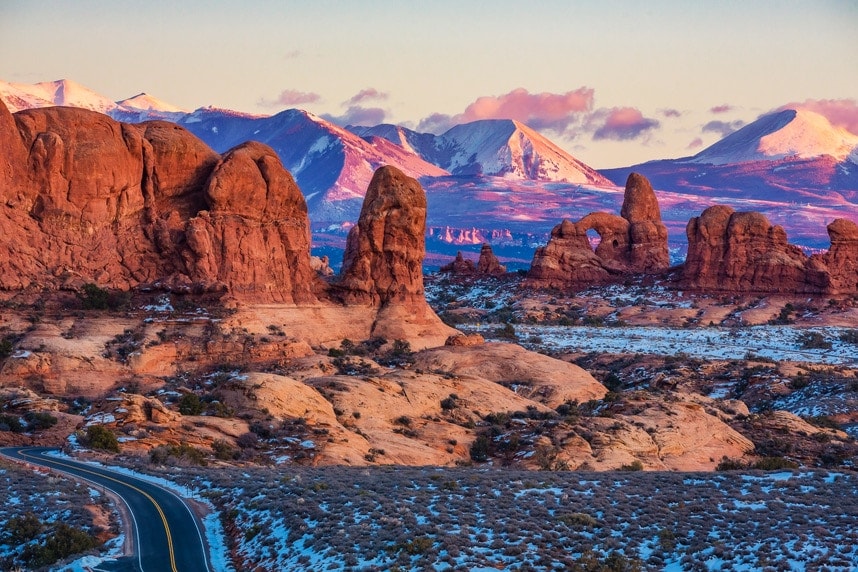You Can’t Miss Visiting Arches National Park & Dead Horse State Park in Utah

We’ve been very fortunate on our tour of the Western United States to get to see some of the most wonderful national and state parks. In Colorado, we visited Rocky Mountain National Park and the Colorado National Monument, and as we made our way through Utah we were able to take in two more: Arches National Park and Dead Horse Point State Park.
Utah State and National Parks
Utah is rich in scenic landscapes and is home to over 20 national and 40 state parks, most within a few hours drive of Salt Lake City. You’re no doubt familiar with Zion, Bryce and Arches National Parks, all awe-inspiring and a photographer’s dream. But there are also many state parks that span the depth and breadth of Utah and take advantage of the rocky moonscapes and lush green rivers, and those that give a nod to the history of this state.
During our research, it was hard to pick out just two to visit as we passed through Utah. We certainly wish we could have visited them all, but with the limited time, we focused our efforts on one of each.
Since Arches National Park was somewhat on the path along our road trip we decided that was a must! And very close to this Arches National Park is Dead Horse State Park which is how we were able to visit both of them and not spend a lot of additional time driving.
Arches National Park
Arches National Park Facts
Established in 1929, Arches National Park is a geologic wonder that’s evolved over 65 million years. Chief among these wonders are the over 2,000 sandstone arches in varying shades of orange and red, the highest density of natural stone arches in the world. That alone is worth the trip, but there is oh so much more. In fact, there are almost 77,000 acres of things to see here.
Located in what is considered the high desert region of the Colorado Plateau, the arches are joined by expansive canyons, scrubland, petrified dunes, and the mighty Colorado River (on its southernmost border). You’ll find a fair amount of wildlife here as well, from desert bighorn sheep and mule deer to fox and cougar, down to rattlesnakes and lizards.
Arches National Park is considered a land of extremes when it comes to temperatures. While we visited in the wintertime, we found daytime to be fairly moderate. Temps tend to range between 30 and 50 during the day and drop as low as 0 at night. Summer temps can push the mercury over 100 degrees during the day and drop dramatically by 30 or 40 degrees at night, not to mention late-summer monsoons that can leave you drenched. So it’s best to come prepared, no matter the season. Cold weather gear for winter and evenings, rain gear, layers you can peel off during the day, and lots of sunscreen no matter the time of year.
The park is open year-round, 24 hours a day. The Visitor Center, just off Highway 191, is open daily. Hours vary by season, but is always welcoming between 9am and 4pm Like all national parks, there is an entrance fee to visit Arches National Park. You can get 7-day passes for $25, which covers a vehicle and its occupants, or an annual pass for $80.
Where is Arches National Park
Arches National Park is located in Moab, Utah, on the eastern side of the state less than 30 miles—as the crow flies—from the Colorado border. Your options are limited when it comes to getting to this scenic park and all require the last let of your journey to be by vehicle.
Getting to Arches National Park By Plane
There are three airport options, all of which will require drive time from the airport to the park. The closest airport is Grand Junction Regional Airport in Colorado, which has flights from multiple hubs (Salt Lake, Denver, Phoenix, and Dallas). Salt Lake City International Airport is the next closest option, with all national carriers having a presence there. Finally, you can fly into Las Vegas, which has the most airline options.
Getting to Arches National Park By Train
Amtrak runs the California Zephyr with daily service between Emeryville, California and Chicago, Illinois. It does make a stop in Green River, Utah, which is about 48 miles from the park.
Getting to Arches National Park By Car
No matter whether you fly in or train in, you will need a car to get you from Point A to Point B. No getting around it. From Grand Junction it is a 1.5-hour drive; from Salt Lake, you can make it in about 3.5 hours. From Las Vegas, it is a long 6.5-hour drive. You can, however, visit multiple state and national parks along the way. Your shortest route is from Green River, a mere 50-minute jaunt.
Best Hikes in Arches National Park
So many options, so little time! But really, you can’t go wrong on any of the hikes and there are so many types to choose from. The hikes at Arches National Park range from easy to difficult so before selecting a trail make sure you’re prepared for how long it will take and wear the appropriate footwear.
One the most important things to remember is to stay off the arches, you’re not allowed to climb, stand, walk, or rappel off any of the arches in the park. The NPS is working to protect this natural beauty so make sure not to do anything crazy and be respectful of this magnificent location!
If we had to pick a few that are those no-miss, photographic wonders, then here they are:
Landscape Arch – Easy Trail
This is considered an easy trail, only 1.6 miles round trip on a relatively flat hard-packed surface, making it navigable by all ages. Which is a good thing, because Landscape Arch is the largest natural rock arch in the world and worth seeing by everyone.
Turret Arch and Window Trail – Easy Trail
This is the trail map you see in the photo below. We did this trail because it’s very simple and the trails lead you to the huge North Window, South Window, and Turret Arch. This is one of the most popular trails because of the famous windows area. You get some amazing views, get a chance to take some spectacular photos and it’s a place where you can sit and take it all in.
Delicate Arch – Difficult Trail
One of the most recognizable features of Arches National Park, Delicate Arch rises up 65 feet into a loop. This is the arch you see in a postcard, the state license plates and is one of the “icons” of Utah. The trail is considered difficult. It is only 3 miles round trip but typically takes 2 to 3 hours. You are exposed to the elements the whole time, with nary a place of shade to be found.
Fiery Furnace – Difficult Trail
This is another difficult trail and requires a permit or hiking with a ranger-led party. The trail snakes between those towering red rocks through narrow sandstone canyons and is often referred to as a maze. I use the word “trail” loosely as there is no established trail here. The ranger-led tour is 2 miles, but with a permit, you can feel free to roam anywhere in the area. But be warned, the official website says that this trail “requires agility to explore.”
In addition to hiking, there are a lot of other things to do, particularly in the summer. There is camping, river rafting, rock climbing and ATV tours. You can backpack and do canyoneering in the backcountry, but these activities do require a permit.
If you want to see the entire list of hiking trails visit the NPS website.
Arches National Park at Night
While we thought that Arches National Park was spectacular during the daytime, seeing it at night is a whole other ball game. Being so remote, there are no city lights, just the light of the moon and the stars. And, oh the stars…. They come out by the millions, dotting the sky in a way that many Americans never get to see. It’s one of those things that leaves you dumbstruck, unable to articulate what you are seeing and feeling.
With the right camera, you can capture the moment to take home with you, like we did.
Dead Horse Point State Park
About Dead Horse Point State Park
While not quite as dramatic as Arches National Park, Dead Horse Point State Park has long wide plateaus, vertical cliffs, multiple carved canyons, a valley floor covered in scrub, and a link to the Colorado River. It’s a fraction of the size of Arches at only 5,362 acres, but the drama of the landscape is undeniable.
This is high desert, and weather conditions are similar to Arches National Park. You’ll experience cold weather and snow in the winter and some scorching days during the summer, although evening temps can plummet.
Dead Horse State Park is open year-round, from 6 a.m. to 10 p.m. The Visitor Center is open daily from 9am to 5pm
How to Get to Dead Horse Point State Park
Like Arches National Park, Dead Horse State Park is located in Moab, Utah. That being said, Dead Horse State Park is about 30 miles from the western border of Arches National Park, making it an easy drive if you are already visiting Arches.
See the information above about how to get to Arches National Park via plane and train transport, as those are the closest airports and train stations to Dead Horse State Park. Tack on 30-45 minutes to each drive to get you here from Arches National Park.
Things to Do in Dead Horse Point State Park
Hiking in Dead Horse Point State Park
There are seven miles of hiking trails in Dead Horse Point State Park and they connect eight different overlooks, affording you some beautiful vistas and amazing opportunities for photos. The trails are all considered pretty easy, but you can traverse some uneven and slick rock areas, so make sure your footwear is appropriate to the terrain.
If you do nothing else, make sure you take the 200-foot Dead Horse Point Overlook Trail. From the end of the trail, you can see the Colorado River snaking through the canyon, making its way west. You can almost imagine how it carved out the stone in past millennia to make the landscape what it is today.
Geocaching in Dead Horse Point State Park
Bring your own GPS unit or rent one from the Visitor Center and spend the day exploring. You just might find any of the three official geocaches located within the boundary of the park. So that children can enjoy this activity as well, the caches are located in easily accessible areas. You will not need to go far off the trail or up or down any cliffs or rocky landscapes (which is prohibited anyway!).
Biking in Dead Horse Point State Park
There is an Intrepid Trail System at Dead Horse Point State Park. It consists of 16.6 miles of single-track trails. Grab a bike and wind through the junipers and pinyon trees, over slickrock and all sorts of terrain. There are trails for beginners, as well as intermediate and expert trails.
Stargazing in Dead Horse Point State Park
Dead Horse Point State Park was recognized as an International Dark Sky Park in 2016. This means it is one of the most active and accessible areas in Utah to stargaze. Join a ranger-led program or bring your own telescope and see the wonders of the universe right above our heads. Although, honestly a telescope isn’t even necessary. Just grab a blanket, lie down and stare in awe at the millions of stars overhead. Just don’t forget to wish on a shooting star as it passes by.
Camping in Dead Horse Point State Park
Dead Horse Point State Park has two campgrounds (Kayenta and Wingate) and several yurts available. Both are open year round with reservations available through Reserve America.
We hope you’re enjoying our journeys across the country. Pretty soon we’ll be sharing our trips from around the world, including Australia, Japan, and Bali!
Happy Travels!
-V






